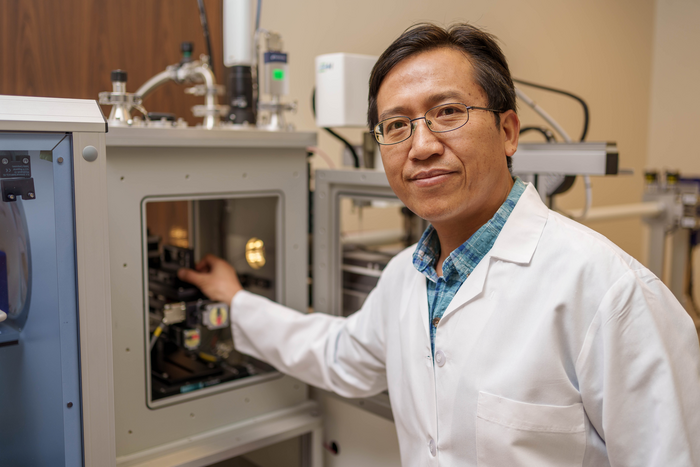Over 2.8 million Americans get antibiotic-resistant bacterial infections anually, and about 35,000 of those patients do not make it through their infection, according to the Centers for Disease Control and Prevention.
 TTUHSC’s Hongjun (Henry) Liang, Ph.D., received a patent that allows his lab to produce novel nanoparticles known as nanoantibiotics that can kill some pathogens that lead to infection without affecting healthy cells. Image Credit: Texas Tech University Health Sciences Center.
TTUHSC’s Hongjun (Henry) Liang, Ph.D., received a patent that allows his lab to produce novel nanoparticles known as nanoantibiotics that can kill some pathogens that lead to infection without affecting healthy cells. Image Credit: Texas Tech University Health Sciences Center.
Hongjun (Henry) Liang, Ph.D., of the Texas Tech University Health Sciences Center (TTUHSC) Department of Cell Physiology and Molecular Biophysics, has largely focused his research on creating novel nanoparticles known as nanoantibiotics that address bacterial infections, particularly those that are resistant to treatment with commonly used antibiotics, to find solutions to the problem of antibiotic resistance.
As of July 26th, 2022, a US patent titled “Hydrophilic Nanostructured Membrane Active Antimicrobials With High Activity, Selectivity And Biodegradability” had been issued in connection with Liang’s work, enabling the Liang laboratory team to manufacture the innovative nanoantibiotics.
We have a lot of antibiotics already being used in the clinics, and many of them are quite effective to ordinary infections. But we are facing this increasing challenge with MRSA (methicillin-resistant staphylococcus aureus) and other kinds of drug-resistant bacteria, which are the bacteria that turns ordinary infections into life-threatening events.
Hongjun Liang, Department of Cell Physiology and Molecular Biophysics, Texas Tech University Health Sciences Center
Liang wants to create a new class of antibiotics that can kill bacteria without harming healthy cells, degrades naturally in the environment and the biosphere, so it does not disrupt the natural bacterial activity in natural settings, and is less likely to lead to resistance.
The ability of a molecule to repel water (hydrophobicity) or to attract water and dissolve in it (hydrophilicity) has been shown to have a major impact on cells in previous studies. According to Liang, a material will have a higher negative effect the more hydrophobic it is.
He emphasized that there is, however, no quantitative benchmark for the acceptable level of hydrophobicity.
Liang added, “Basically, you can kill bacteria when you increase hydrophobicity. But it also will kill healthy cells, and we don’t want that.”
The Liang team created unique hydrophilic nanoantibiotics in a study published in January 2022 in Nature Communications. These nanoantibiotics had the appearance of tiny hairy spheres and were made of many hydrophilic polymer brushes grafted onto silica nanoparticles of various sizes.
These man-made substances, which are also produced by Liang’s lab, are intended to kill bacteria by disrupting their membranes by utilizing a distinct method of membrane remodeling that affects bacterial membranes while leaving mammalian cells unharmed.
This was the third paper on nanoantibiotics that the Liang lab has published. The first and second publications that described the hydrophilic nanoantibiotic design approach were released in 2017 by ACS Infectious Disease and in 2020 by Biomacromolecules.
Both were highlighted by Chemical & Engineering News and featured as cover stories in their respective journals.
Liang said his team is now concentrating on a two-pronged approach to enhance and improve the nanoantibiotics for use in patients, armed with the three published findings and the patent.
Pushing for clinical trials is the first strategy, which Liang defined as the research and academic component of his approach. The Liang lab will begin that procedure by submitting new applications for federal funding that support animal studies and ultimately result in clinical trials on human subjects.
He stated, “That is more like the research and academic side of our effort.”
Working with the Texas Tech University Innovation Hub to assist in the commercialization of Liang’s lab’s invention is the second element of his approach.
“By taking the training opportunity on research commercialization from our Innovation Hub, hopefully, we are able to identify interested parties in the pharmaceutical industry who are able or willing to collaborate with us. One of our likely directions is to apply for an SBIR (Small Business Innovation Research) grant to pilot scale production. That’s our two-pronged approach,” stated Liang.
Infection is a major concern for both scientists and practicing physicians, according to Liang. By harnessing innovation to develop a new generation of antibiotics, he hopes to be able to overcome this issue.
Liang concluded, “That is our goal and we are well on our way to that. I can’t say this is the only way forward; of course, there are many different ways. The novelty of our contribution is to tackle this challenge by designing antibiotics from a nanoengineering point of view. This is a very new path that is not well explored, and we are proud of our progress so far.”